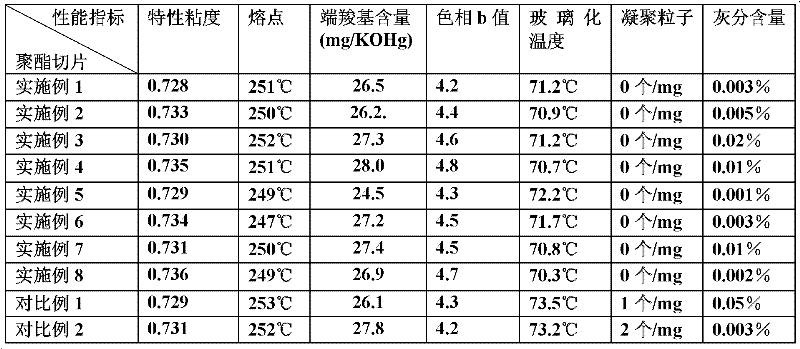Method for preparing polyester fibers with ultraviolet-resistant and anti-pilling composite function
An anti-ultraviolet, polyester fiber technology, applied in the direction of single-component polyester rayon, melt spinning method, stretch spinning method, etc., can solve the problem that the anti-ultraviolet effect needs to be improved, the anti-ultraviolet performance is poor, and it is easy to generate static electricity, etc. problem, achieve the effect of reducing light transmittance, improving diffuse scattering effect, and small kinematic viscosity
- Summary
- Abstract
- Description
- Claims
- Application Information
AI Technical Summary
Problems solved by technology
Method used
Image
Examples
Embodiment 1
[0036] The present embodiment provides a method for preparing an anti-ultraviolet, anti-pilling polyester chip, which comprises the following steps in sequence:
[0037](1), Primary esterification reaction section: Take 18kg of purified terephthalic acid (PTA), 0.52kg of isophthalic acid, and 7.5kg of ethylene glycol (EG) into a 70-liter esterification reaction kettle, stir evenly, and start to heat up And pressurize to 0.3Mpa to carry out esterification, the esterification temperature is controlled at 250-265°C, until the esterification is completed, return to normal pressure, and end the reaction.
[0038] (2) Secondary esterification reaction section: After the primary esterification is completed, ethylene glycol is firstly added to lower the temperature of the reactor to 230-235°C (at a lower system temperature, the various modifications added can be guaranteed The active component is carried out under milder dispersion conditions), then 450g of molten polyethylene glycol ...
Embodiment 2
[0041] The present embodiment provides a method for preparing an anti-ultraviolet, anti-pilling polyester chip, which comprises the following steps in sequence:
[0042] (1), Primary esterification reaction section: Take 18kg of purified terephthalic acid (PTA), 0.52kg of isophthalic acid, and 7.5kg of ethylene glycol (EG) into a 70-liter esterification reaction kettle, stir evenly, and start to heat up And pressurize to 0.3Mpa to carry out esterification, the esterification temperature is controlled at 250-265°C, until the esterification is completed, return to normal pressure, and end the reaction.
[0043] (2), secondary esterification reaction section: after primary esterification is completed, at first add ethylene glycol, make reactor temperature drop to 230~235 ℃, then the number average molecular weight of 450g melting is the polyethylene glycol of 2000 Add to the reaction kettle under the protection of nitrogen, and stir evenly. Then add 1.125g of composite light sta...
Embodiment 3
[0046] The present embodiment provides a method for preparing an anti-ultraviolet, anti-pilling polyester chip, which comprises the following steps in sequence:
[0047] (1), Primary esterification reaction section: Take 18kg of purified terephthalic acid (PTA), 0.52kg of isophthalic acid, and 7.5kg of ethylene glycol (EG) into a 70-liter esterification reaction kettle, stir evenly, and start to heat up And pressurize to 0.3Mpa to carry out esterification, the esterification temperature is controlled at 250-265°C, until the esterification is completed, return to normal pressure, and end the reaction.
[0048] (2), secondary esterification reaction section: after primary esterification is completed, at first add ethylene glycol, make reactor temperature drop to 230~235 ℃, then the number average molecular weight of 450g melting is the polyethylene glycol of 2000 Add to the reaction kettle under the protection of nitrogen, and stir evenly. Then add 1.125g of composite light sta...
PUM
| Property | Measurement | Unit |
|---|---|---|
| Wicking height | aaaaa | aaaaa |
| Evaporation rate | aaaaa | aaaaa |
Abstract
Description
Claims
Application Information
 Login to View More
Login to View More - R&D
- Intellectual Property
- Life Sciences
- Materials
- Tech Scout
- Unparalleled Data Quality
- Higher Quality Content
- 60% Fewer Hallucinations
Browse by: Latest US Patents, China's latest patents, Technical Efficacy Thesaurus, Application Domain, Technology Topic, Popular Technical Reports.
© 2025 PatSnap. All rights reserved.Legal|Privacy policy|Modern Slavery Act Transparency Statement|Sitemap|About US| Contact US: help@patsnap.com



